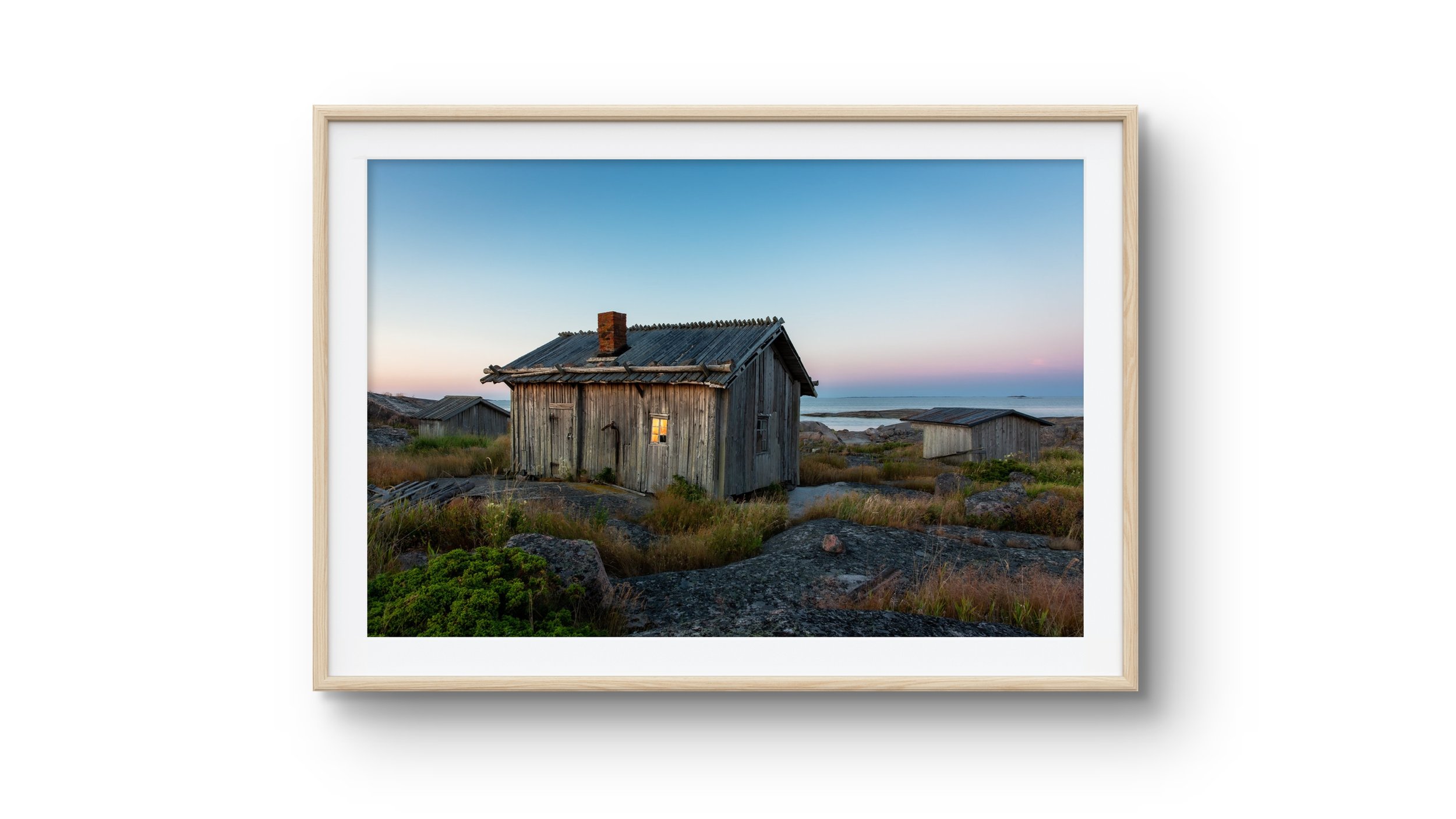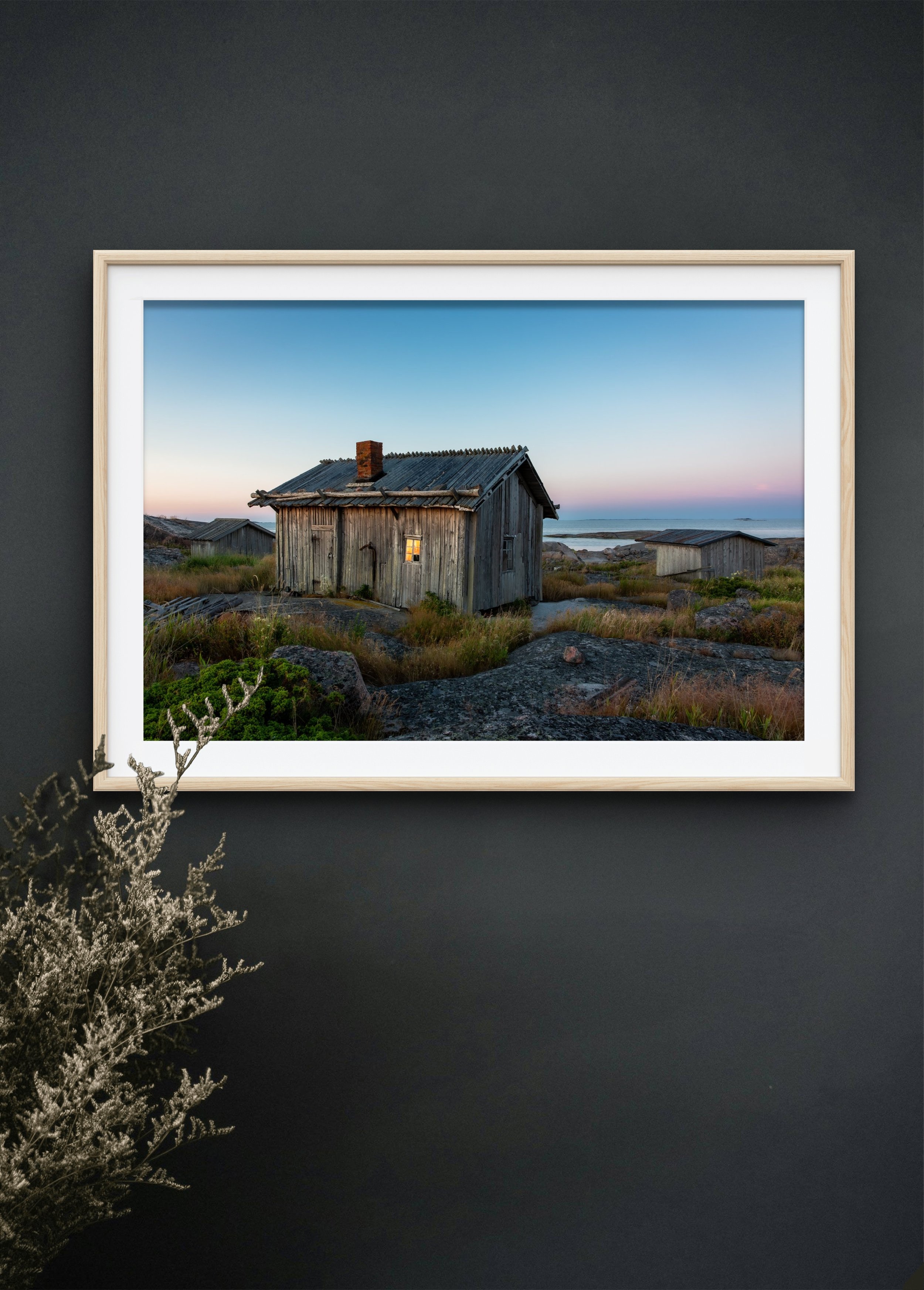Kers fiskehus, Östra Mörskär
On the outer islands of our Archipelago, battered by the winds, remnants of a centuries-old seasonal fishing culture can be found. The boat landings bordered by stones, the ruins, and the few fishing huts still standing whisper of what survival in the archipelago was like in the past. The resilience and amount of work required for seasonal fishing during that time is something that modern people find nearly impossible to comprehend.
Fishing camps were set up in the outermost zone of the Archipelago. It is typical for the islands to have a sheltered natural cove or a fjord-like crevice formed by cliffs, known as a “klova.” Due to land uplift, many of these areas are now too shallow for boat landings.
The fishing huts were brought by boat from the home islands in parts and assembled on-site. Various discarded materials were utilized. However, many lived in their boats, as not everyone had the opportunity to have their own homestead. During storms, the boats were pulled up onto the rocks. It was also common for boats to be pulled up on the rocks at night and turned over for weather protection.
Sailing to the outer skerries was done from near and far. Fishing was divided into summer and autumn seasons, with weeks spent on-site. The most important catch consisted of herring and cod. The bounty of the sea was delivered as far as the markets in Stockholm and Helsinki. The fishing bases provided shelter for those navigating the outer islands and also served other hunting activities, such as seal hunting and bird shooting. Life in the harsh conditions of the outer Archipelago was a continuous struggle against the forces of nature. Many were lost to the waves and ice.
In 1549, in Kökar's most important seasonal fishing area (the Mörskär region), the crown taxed 149 fishing crews for summer fishing and 296 for autumn fishing. Estimating that each crew consisted of 3-4 people gives a sense of the number of individuals who resided on the treeless outer skerries simultaneously. The westernmost base of the Mörskär seasonal fishing area was Västra Mörskär, and the easternmost was Enharu, located near Jurmo.
The centuries-old seasonal fishing culture waned as society industrialized. Sails were replaced by engines, and the younger generation sought an easier life on the mainland. As the fishing livelihood dwindled, the population of the outer islands collapsed. Sea eagles, terns, and seals have long been the masters of these remote reserves.
On the outer islands of our Archipelago, battered by the winds, remnants of a centuries-old seasonal fishing culture can be found. The boat landings bordered by stones, the ruins, and the few fishing huts still standing whisper of what survival in the archipelago was like in the past. The resilience and amount of work required for seasonal fishing during that time is something that modern people find nearly impossible to comprehend.
Fishing camps were set up in the outermost zone of the Archipelago. It is typical for the islands to have a sheltered natural cove or a fjord-like crevice formed by cliffs, known as a “klova.” Due to land uplift, many of these areas are now too shallow for boat landings.
The fishing huts were brought by boat from the home islands in parts and assembled on-site. Various discarded materials were utilized. However, many lived in their boats, as not everyone had the opportunity to have their own homestead. During storms, the boats were pulled up onto the rocks. It was also common for boats to be pulled up on the rocks at night and turned over for weather protection.
Sailing to the outer skerries was done from near and far. Fishing was divided into summer and autumn seasons, with weeks spent on-site. The most important catch consisted of herring and cod. The bounty of the sea was delivered as far as the markets in Stockholm and Helsinki. The fishing bases provided shelter for those navigating the outer islands and also served other hunting activities, such as seal hunting and bird shooting. Life in the harsh conditions of the outer Archipelago was a continuous struggle against the forces of nature. Many were lost to the waves and ice.
In 1549, in Kökar's most important seasonal fishing area (the Mörskär region), the crown taxed 149 fishing crews for summer fishing and 296 for autumn fishing. Estimating that each crew consisted of 3-4 people gives a sense of the number of individuals who resided on the treeless outer skerries simultaneously. The westernmost base of the Mörskär seasonal fishing area was Västra Mörskär, and the easternmost was Enharu, located near Jurmo.
The centuries-old seasonal fishing culture waned as society industrialized. Sails were replaced by engines, and the younger generation sought an easier life on the mainland. As the fishing livelihood dwindled, the population of the outer islands collapsed. Sea eagles, terns, and seals have long been the masters of these remote reserves.
On the outer islands of our Archipelago, battered by the winds, remnants of a centuries-old seasonal fishing culture can be found. The boat landings bordered by stones, the ruins, and the few fishing huts still standing whisper of what survival in the archipelago was like in the past. The resilience and amount of work required for seasonal fishing during that time is something that modern people find nearly impossible to comprehend.
Fishing camps were set up in the outermost zone of the Archipelago. It is typical for the islands to have a sheltered natural cove or a fjord-like crevice formed by cliffs, known as a “klova.” Due to land uplift, many of these areas are now too shallow for boat landings.
The fishing huts were brought by boat from the home islands in parts and assembled on-site. Various discarded materials were utilized. However, many lived in their boats, as not everyone had the opportunity to have their own homestead. During storms, the boats were pulled up onto the rocks. It was also common for boats to be pulled up on the rocks at night and turned over for weather protection.
Sailing to the outer skerries was done from near and far. Fishing was divided into summer and autumn seasons, with weeks spent on-site. The most important catch consisted of herring and cod. The bounty of the sea was delivered as far as the markets in Stockholm and Helsinki. The fishing bases provided shelter for those navigating the outer islands and also served other hunting activities, such as seal hunting and bird shooting. Life in the harsh conditions of the outer Archipelago was a continuous struggle against the forces of nature. Many were lost to the waves and ice.
In 1549, in Kökar's most important seasonal fishing area (the Mörskär region), the crown taxed 149 fishing crews for summer fishing and 296 for autumn fishing. Estimating that each crew consisted of 3-4 people gives a sense of the number of individuals who resided on the treeless outer skerries simultaneously. The westernmost base of the Mörskär seasonal fishing area was Västra Mörskär, and the easternmost was Enharu, located near Jurmo.
The centuries-old seasonal fishing culture waned as society industrialized. Sails were replaced by engines, and the younger generation sought an easier life on the mainland. As the fishing livelihood dwindled, the population of the outer islands collapsed. Sea eagles, terns, and seals have long been the masters of these remote reserves.




